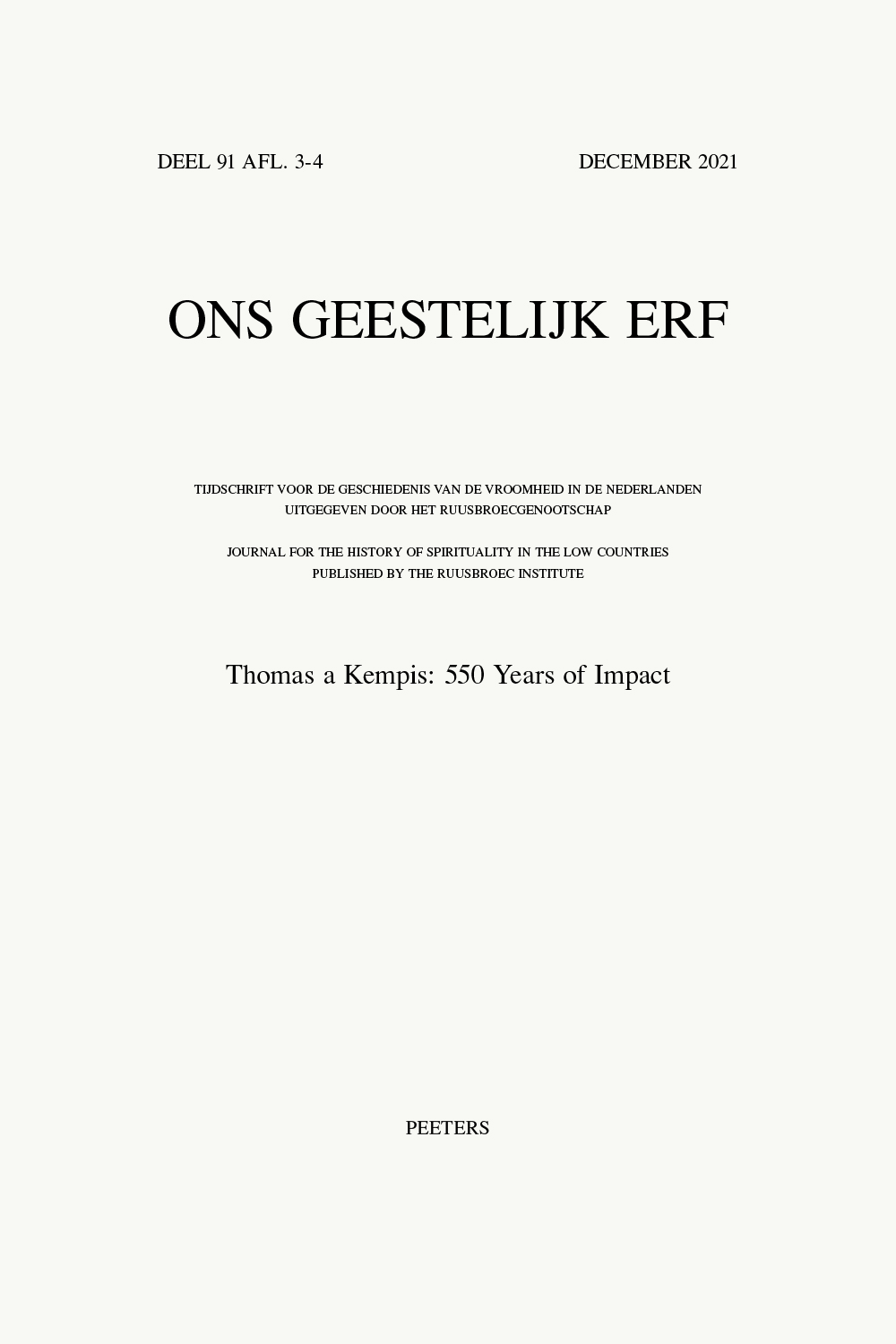next article in this issue  |

|
Document Details : Title: Studie en kritische tekstuitgave van Henricus Pomerius' De origine monasterii Viridis Vallis Author(s): KORS, Mikel M. Journal: Ons Geestelijk Erf Volume: 87 Issue: 3-4 Date: 2016 Pages: 227-331 DOI: 10.2143/OGE.87.3.3239920 Abstract : The present article has as its main objective to publish the first critical edition of Henricus Pomerius’ De origine monasterii Viridis Vallis, written between 1413 and 1417 in the monastery of Groenendaal, based on all extant manuscripts. The former edition, from 1885, established by the Bollandist De Leu, was based on only one complete manuscript plus one codex with a partial text (the part on Ruusbroec). Since De Leu presented the text, many more manuscripts and even a Middle Dutch translation have come to our knowledge. A new edition of the text was consequently a desideratum for decades already. Pomerius’ De origine is one of the most important sources about the foundation of the monastery of Groenendaal and its first inhabitants. It has played a very important role in the research on Ruusbroec ever since its publication until nowadays. Its content was heavily contested though, and some historians even accused Pomerius, in the presentation of his material, of deliberately lying. This new edition will hopefully put the facts into (a milder) perspective. The new critical text edition is accompanied by an extensive introduction. First we discuss the attribution and authenticity of the treatise. Based on text internal and external elements we come to a more precise date for its composition: 1413-1417. Next, we examine the ‘protovita’ of Ruusbroec and Jan van Leeuwen, a text now lost, but there is plenty of contemporary evidence that it did exist. Jan van Schoonhoven, an eyewitness of Ruusbroec’s last years, might have written this protovita. At first glance, it seems rather strange that Pomerius nevertheless made a new treatise, but we have to consider that Pomerius’ aim was very specific: his objective with De origine was, in the words of Vanderputten, to connect every fact of the Groenendaal community with the biography of the two ‘holy’ predecessors, Jan van Leeuwen and Jan van Ruusbroec, and vice versa. The occasion to write a new history of Groenendaal might also be found in the circumstance that around 1410 a renewed fight against the movement of the Free Spirit had commenced, in which the prior of Groenendaal partook. Ruusbroecs work had never been exempt of accusations of heresy; therefor a clear defence of his orthodoxy was more than welcome. Apart from the protovita, there were two small Latin texts about Ruusbroec’s life and the foundation of Groenendaal: one is a passage in Jan van Schoonhoven’s letter of defence against Jean Gerson, the other one is written by Sayman van Wijc as a kind of introduction to the Groenendaal Obituary. Only Sayman’s text shows some connections with De origine. Both texts are presented, on the base of extant editions. In the second paragraph we present and discuss the extant Latin and Dutch manuscripts. Many can be located in Brabant, and most of them are written either in Rooklooster or in other monasteries connected to the Chapter of Windesheim. In the third paragraph we focus on the history of the text. The manuscript tradition only starts about half century after the completion of De origine, as is attested by a passage in Thomas a Kempis’ Chronicon Montis Sanctae Agneti. We show that De origine remained an unfinished text and that later a Conclusio was added, in order to give the treatise a more definite look. Most of the manuscripts, contrary to the codex used by De Leu, still represent the unfinished version. We also shortly discuss the Middle Dutch translation, which proves to be based on one specific Latin manuscript, Brussels, KB, 2926-28. Therefor it is of no value for the establishment of the Latin critical text of De origine. In the fourth paragraph we discuss some of the sources that Pomerius used or might have used for De origine, especially Jan van Leeuwen and some texts transmitted in the rapiarium Brussels, KB, 2559-62. We come to the conclusion that some parts were quoted and translated almost literally, whereas others offered mainly, if at all, a framework for anecdotes. The fifth paragraph is devoted to the manuscript tradition. We try to establish the relationship between the manuscripts and present a stemma. We chose Vienna, ÖNB, SN 12708 as the basic manuscript for the present edition of De origine. It was copied around 1485 by the historian Johannes Gielemans, in the monastery of Rooklooster, only a few miles in distance from Groenendaal. In chapter 6, finally, we present our critical edition of De origine, followed by a variant apparatus, an extensive critical commentary in which we treat all relevant variants and a list of sources, biblical and others. |
|
